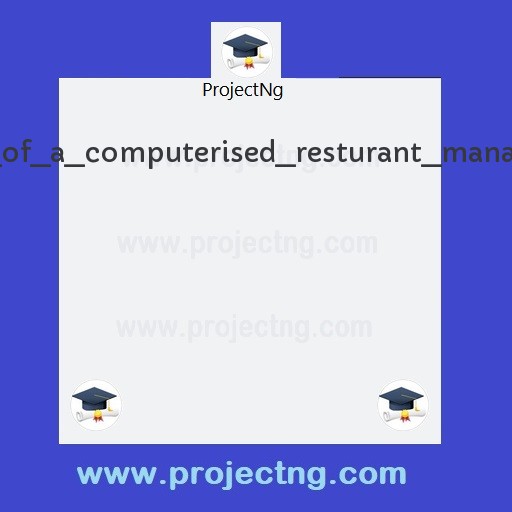Design and implementation of a computerised resturant management information system
Computer Engineering Project Topics
Get the Complete Project Materials Now! »
DESIGN_AND_IMPLEMENTATION_OF_A_COMPUTERISED_RESTURANT_MANAGEMENT_INFORMATION_SYSTEM
CHAPTER ONE
INTRODUCTION
Computerised restaurant management information system is database program that keeps record of all transaction carried out in the restaurant on daily bases. The system helps the restaurant management to keep adequate record of all transactions carried out and does that will still be carried out by the restaurant and maintain the database of the restaurant.
1.1BACKGROUND OF THE STUDY
Various types of fall into several industry classifications based upon menu style, preparation methods and pricing. Additionally, how the food is served to the customer helps to determine the classification.
Historically, restaurant referred only to places that provided tables where one sat down to eat the meal, typically served by a Waiter. Following the rise of Fast food and restaurants, a Retronym for the older "standard" restaurant was created, sit-down restaurant. Most commonly, "sit-down restaurant" refers to a casual dining restaurant with Table service, rather than a or a "diner", where one orders food at a Countertop. Sit-down restaurants are often further categorized, in North America, as "family-style" or "".
In, the term restaurant almost always means an eating establishment with table service, so the "sit-down" qualification is not usually necessary. Fast food and takeaway (take-out) outlets with counter service are not normally referred to as restaurants. Outside of North-America, the terms fast casual dining restaurants, family style, and casual dining are not used and distinctions among different kinds of restaurants is often not the same.
2
In France, for example, some restaurants are called "bistros" to indicate a level of casualness or trendiness, though some "bistros" are quite formal in the kind of food they serve and clientele they attract. Others are called "brasseries," a term which indicates hours of service. "Brasseries" may serve food round the clock, whereas "restaurants" usually only serve at set intervals during the day.
In Sweden, restaurants of many kinds are called "restauranger," but restaurants attached to bars or cafes are sometimes called "kök," literally "kitchens," and sometimes a bar-restaurant combination is called a "krog," in English a "tavern."
In Dishing It Out: In Search of the Restaurant Experience, Robert (2002) argues that all restaurants can be categorized according a set of social parameters defined as polar opposites: high or low, cheap or dear, familiar or exotic, formal or informal, and so forth. Any restaurant will be relatively high or low in style and price, familiar or exotic in the cuisine it offers to different kinds of customers, and so on.
Context is as important as the style and form: a taqueria is a more than familiar site in Guadalajara, Mexico, but it would be exotic in Albania. A Chris restaurant in North America may seem somewhat strange to a first time visitor from India; but many Americans are familiar with it as a large restaurant chain, albeit one that features high prices and a formal atmosphere.
3
1.2 STATEMENT OF THE PROBLEMS
Sales and services are the fundamental tools in any business organization the profit and loose of any business depends on detailed information on sales and services made to aid in decision making and implementation, if accountability is not checked, then the business is sure to collapse, as a result in a any retail and hospitality business there is a need for a system that gives feedback to the management to aid decision making, this is where computerized management information system comes handy
Besides, staffing a restaurant can be tricky because demand for food will likely fluctuate dramatically, often due to variables that you cannot track. Identify any variables you do observe that influence traffic in your restaurant, such as weather and day of the week. Build a weekly schedule to staff your restaurant in accordance with these variables, such as scheduling additional staff on Saturday night if that is your busiest shift.
Compile data about sales and employee hours to determine a profitable ratio of employee hours to sales totals. Restaurant personnel training systems are also vital to success, ensuring that employees know company protocol and systems, and are capable of delivering a high quality product. Write a comprehensive employee manual detailing information that each member of your staff should know.
Besides, customers are not able to ask about quality of food or ask for any specialized diet foods. It is more difficult to ask for gluten free or allergy free foods with computerized ordering. Also, it is more possible for a customer to place an order, but never pick up the order which can lead to waste of food and possibly a loss of profits.
4
1.3 OBJECTIVES OF THE STUDY
The main objectives of the study are the Design, Documentation and Implementation of a Computerized Restaurant Management Information System. While the subsidiary objectives are: To determine how computerized management information system has facilitated increase productivity, decrease paperwork, and ability to analyze trouble spots. To determine how the system will increase the level of services quality and
Customer satisfaction To determine how the system will help the restaurants to have the ability to build competitive and strategic advantages by better understanding the needs and wants of the guests, hence building repeat business. To determine how the system can lead organization towards better decision making and building a competitive advantage over its competitors. To determine how computerized management information system will improve the operating efficiencies, provide restaurant and support center management with timely access to financial and operating data and reduce administrative time and expense
Be the First to Share On Social

Enjoying our content?
Don't miss out on new videos! Subscribe to our YouTube channel for more awesome content.
Subscribe Now!













